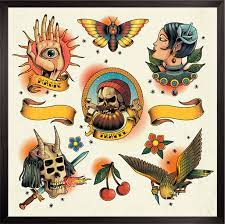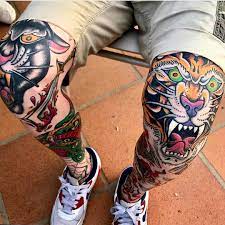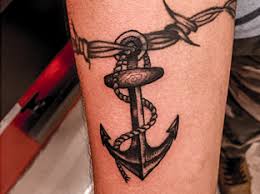
Tattoo shops typically display classic designs known as flash on their walls as references for customers who need an idea of what tattoo they want.
Origins
Traditional Tattoos are timeless classics. Bodacious lines, classic designs, and limited color choices have made this art form popular in shops. Before the days of custom work and tattoo renaissance artists, standard flash sheets were displayed at tattoo shops for customers to select their design and allow the tattooist to quickly ink it.
Pre-drawn designs, commonly called flash, were introduced in New York City in the early 1900s by Lewis “Lew the Jew” Alberts’ tattoo supply company. They practiced printing flash sheets, which tattooers could use as templates when creating their designs. Tattoo artists today still share creations electronically, usually by creating flash sheets for sale in their shop or to add to their portfolio online.
Designs
Traditional tattoo designs feature bold black outlines with limited color palettes that remain popular today. Many tattoo artists still employ these tried-and-tested designs to meet demand. The eagle is often used as an iconic symbol, representing power and courage. Additional elements like stars or clouds may be added for added interest to form an integrated piece.
Before the advent of electric tattoo machines, artists would trade flash designs with each other or hang them as advertisements to showcase their services. Most tattoo artists used quality drawing pencils or markers like Micron or Prismacolor colored pencils to shade and blend designs, sometimes adding pops of color using watercolors as well. However, this flash art would often fade with time.
Techniques
Traditional Tattoos typically feature bold lines and limited colors, with timeless motifs from legendary tattooists such as Bert Grimm, George Burchett, and Sailor Jerry. These iconic motifs have stood the test of time to become part of American culture.
Traditional Tattoos give customers an advantage – they don’t need to come into a shop and hand-draw their design. Instead, they can bring in an image they would like for inspiration, and their artist will use this picture as their guide and create their tattoo accordingly. Most tattoo artists use high-quality drawing pencils or markers when drawing their flash, with some using Micron or Prismacolor colored pencils to add ink. A good quality black ink pen is often used to outline designs for added dimension and bring Tattoos to life.
Symbolism
Tattoos were traditionally popular among sailors and soldiers. By sharing ideas and designs among themselves, sailors helped the industry flourish. Flash sheets were exchanged among artists as a means to meet increasing demand. These flash sheets could even be ordered directly through mail-order catalogs.
These flash sheets featured tattoo artists’ motifs they had been tattooing for years or decades – from religious iconography and symbolism, courage/strength icons, and pin-up girls to intricate pin-up scenes. A wolf symbolizes power and fierceness, while snakes symbolize base desires. Both are often linked with the number 13, considered unlucky. However, Sailor Jerry used eagles to represent an idealized America, where citizens stood up for what they believed in and didn’t back down for anyone.

